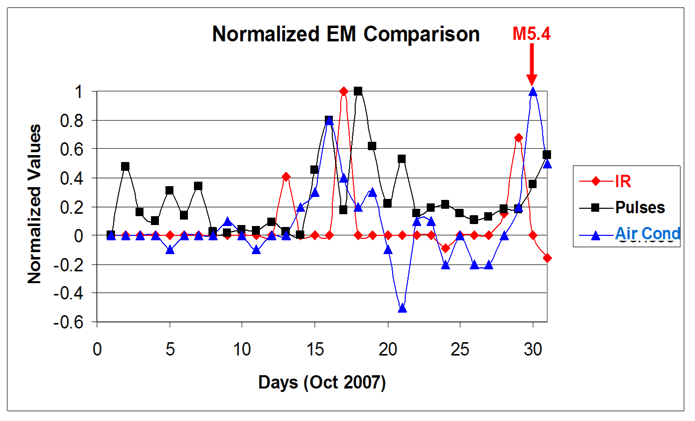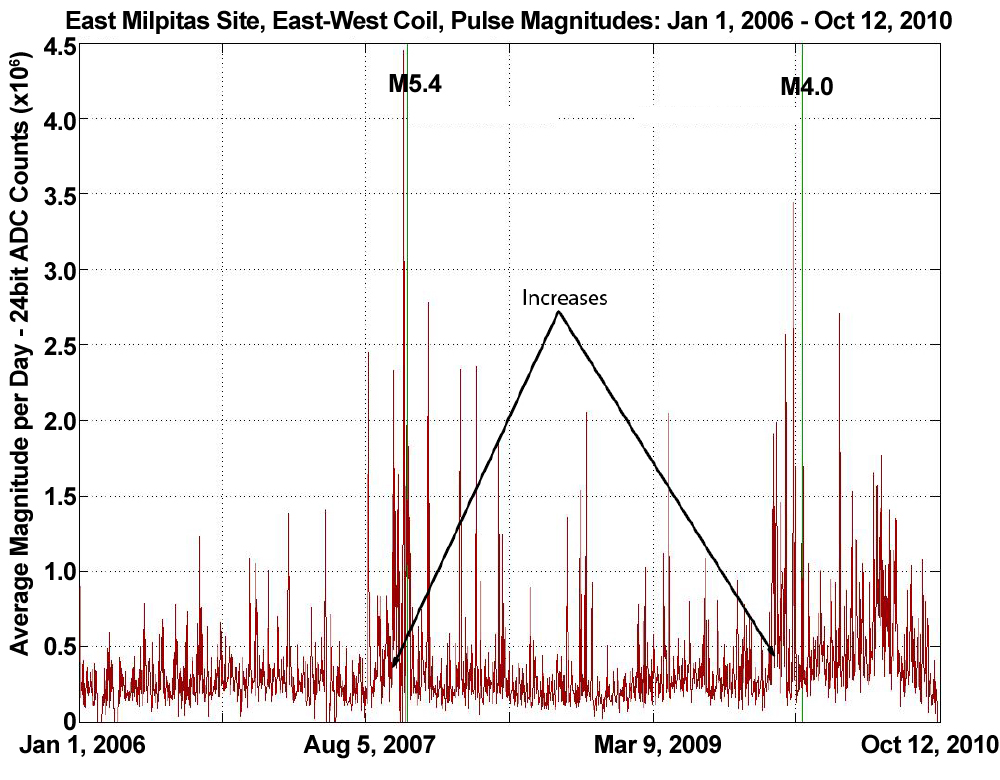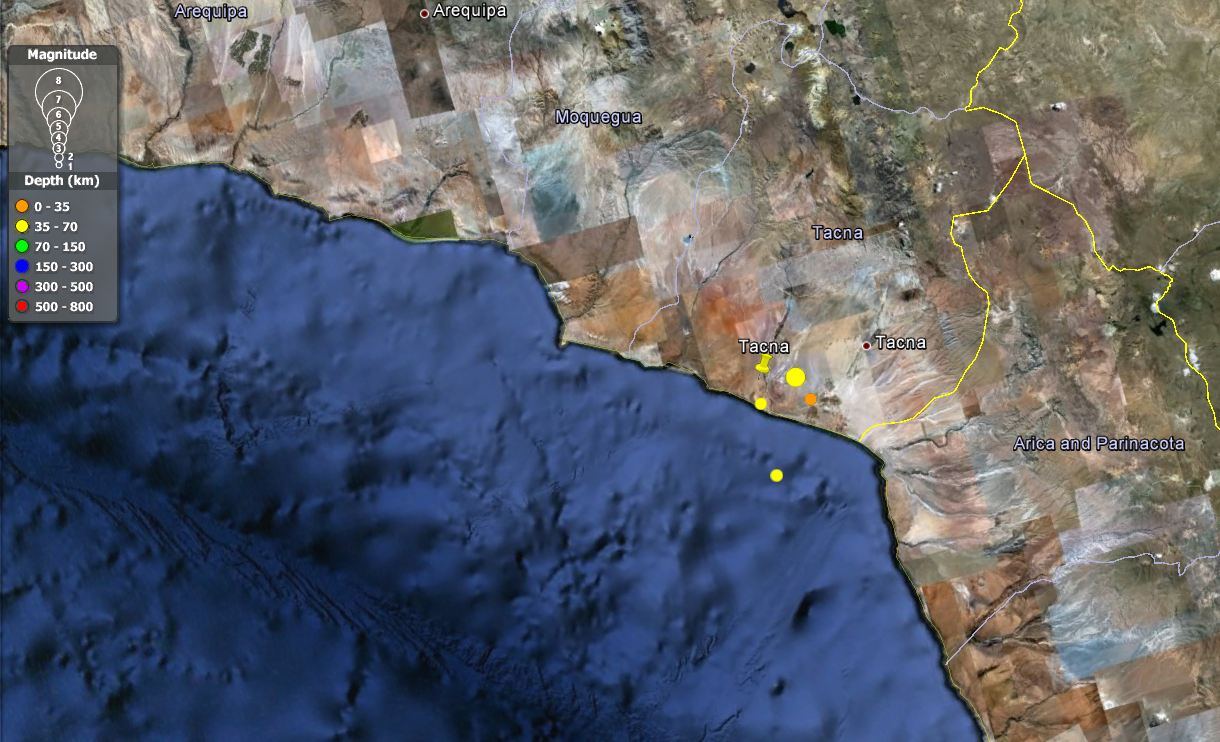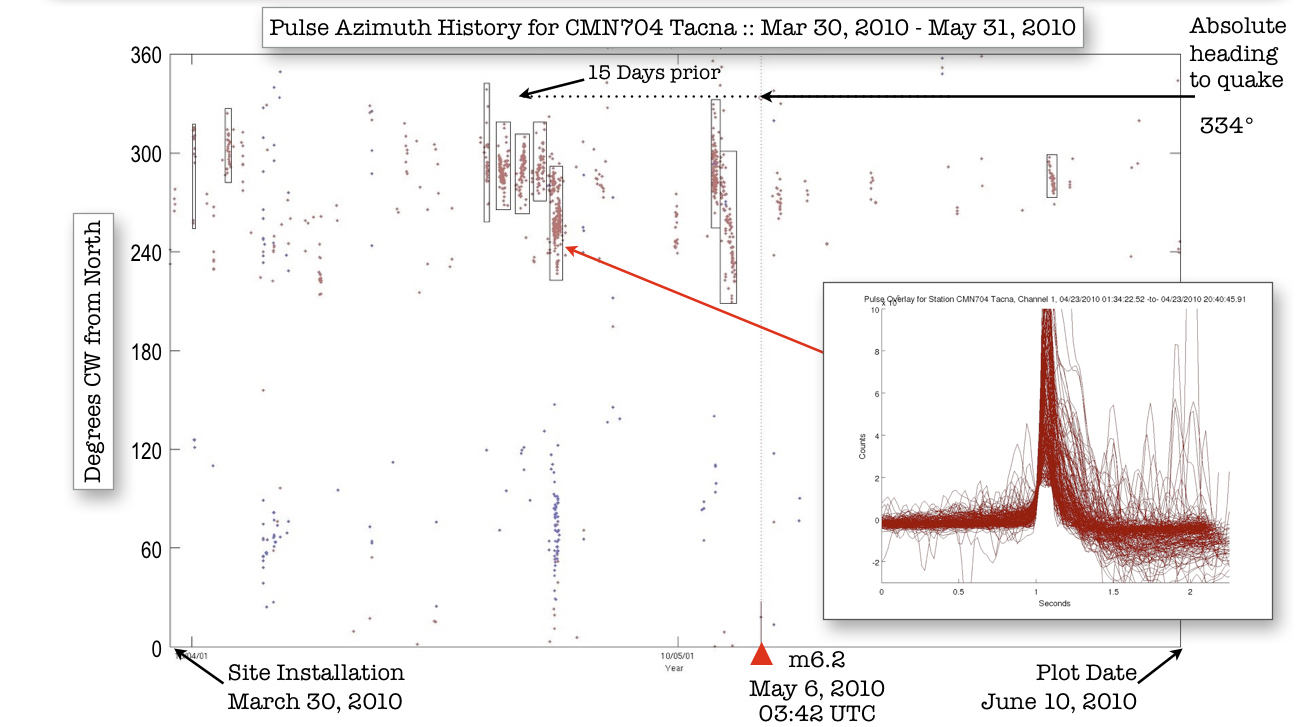About QuakeFinder History

Inspired by a 1985 talk on “earthquake lights” by USGS scientist John Derr, QuakeFinder founder Tom Bleier embarked on a search for electromagnetic signals associated
with earthquakes. Starting with a tree as an antenna, and progressing to a 20-foot copper coil on the wall of his house, he looked for anything in the data that might provide an explanation for the lights or as reported in scientific papers, the radio interference before earthquakes in Chile
and Japan. But like others before him, he found nothing.
Then in 1989 the Loma Prieta M7.0 quake struck the San Francisco Bay area. Analysis of magnetometer data collected by Dr. Tony Fraser-Smith and Stanford clearly showed ultra-low frequency magnetic signals appearing two weeks prior to the quake. This “proof of concept”
spurred Bleier to continue his quest. Designing a low-cost instrument that could be deployed near faults to try and capture more examples like Fraser-Smith’s, he worked with science programs at high schools near faults around California to help students build and install sensors.
Ten years later, when Bleier’s work at aerospace engineering firm Stellar Solutions reached a turning point, his conversations with company owner Celeste Ford turned to the possibility of forecasting earthquakes. Inspired by the potential of a disruptive technology that could save lives,
Ford threw the support of Stellar behind the idea. The pair founded QuakeFinder in 2000 to bring professional focus and more resources to the project. Starting by expanding the high school program, QuakeFinder quickly moved to develop and deploy more sophisticated and sensitive
instruments.


A major breakthrough came in 2007, when an M5.4 earthquake occurred very close to a QuakeFinder instrument located at East Milpitas, California (2 Km). Reviewing the data recorded before the date of the quake, October 30, 2007, researchers discovered a distinct pattern of
ultra-low frequency magnetic pulses starting two weeks before the quake, and disappearing after the event. They correlated this data with results from air ionization sensors and infrared imaging of the area, and found a clear alignment between the indicators. It would be nearly three
years before QuakeFinder would observe another quake large enough and close enough. This would be the January 7, 2010 M4.0 earthquake, which was 7 Km from the same instrument at East Milpitas. This time the pulses also appeared within a two week window prior to the
earthquake, and they were smaller, and there were fewer of them. This may be consistent with the fact that the second earthquake was lower magnitude, and further away from the instrument.

Later in 2010, QuakeFinder’s international expansion paid off immediately when an instrument installed near the Southern border of Peru recorded pulses prior to a M6.2
earthquake on May 5th. Again, the pattern was very clear with the signal showing up predominantly in the two weeks prior to the earthquake. A cluster of quakes between M4 and M5 continued to shake the region, and the pulse count remained elevated.
Of the many aspects of these complex signals, perhaps one of the most telling facts is that when the seismic activity ends, the signals decline sharply. Another fact is that many signals seen in induction-coil magnetometers “bounce back,” like after a car passes, or as an electric
motor turns. But the pulses that QuakeFinder has reported in its
published papers are
uni-polar, like the signals we see when lightning strikes near one of our sites. The
implication is that charge may be moving from one location to another, near our instruments.
A number of reports about electrical effects in the atmosphere led Bleier in 2005 to begin deploying sensors that might sense changes in the conductivity of the air. Normally air is a pretty good insulator, but if an excess of ions or electrons are present, the air becomes a better
conductor of electricity. Most theories about electrical effects originating from a seismic region indicate that the air in the area will contain free charges, and we saw the Air Conductivity signal respond at East Milpitas. Now QuakeFinder has deployed much more sensitive ion detectors,
providing separate channels for positive and negative charge. These new sensors may bring deeper understanding of the complex charge exchanges that can occur in seismic regions.

In 2011, QuakeFinder published a
paper which showed that the pulses we observed produce stable patterns of amplitude when considering two coils at once. It was discovered that
mapping the North-South coil against the East-West coil produces a highly structured signal, where the pulses cluster not only in time, but also in angle of arrival.
Around the same time QuakeFinder began deploying its fifth-generation sensor, the QF2010, based on the specialized QFIDO coil. The product of much tuning, the QFIDO can reproduce the shape of geomagnetic pulse waveforms up to 10 seconds in length. There is much hope
that analyzing the characteristics of pulse waveforms can lead to better understanding of the very rich phenomenon that is found in low frequency geomagnetic pulses.
The new QF2010 is also solar powered, and uses several forms of cellular data transfer. This portability opens up many exciting possibilities for site locations. With over 60 sites planned for expansion in 2012 alone, the QuakeFinder network continues to seek its goal of complete
coverage of California, and its international sites in Peru, Taiwan, Greece, and beyond.
 Inspired by a 1985 talk on “earthquake lights” by USGS scientist John Derr, QuakeFinder founder Tom Bleier embarked on a search for electromagnetic signals associated
with earthquakes. Starting with a tree as an antenna, and progressing to a 20-foot copper coil on the wall of his house, he looked for anything in the data that might provide an explanation for the lights or as reported in scientific papers, the radio interference before earthquakes in Chile
and Japan. But like others before him, he found nothing.
Then in 1989 the Loma Prieta M7.0 quake struck the San Francisco Bay area. Analysis of magnetometer data collected by Dr. Tony Fraser-Smith and Stanford clearly showed ultra-low frequency magnetic signals appearing two weeks prior to the quake. This “proof of concept”
spurred Bleier to continue his quest. Designing a low-cost instrument that could be deployed near faults to try and capture more examples like Fraser-Smith’s, he worked with science programs at high schools near faults around California to help students build and install sensors.
Ten years later, when Bleier’s work at aerospace engineering firm Stellar Solutions reached a turning point, his conversations with company owner Celeste Ford turned to the possibility of forecasting earthquakes. Inspired by the potential of a disruptive technology that could save lives,
Ford threw the support of Stellar behind the idea. The pair founded QuakeFinder in 2000 to bring professional focus and more resources to the project. Starting by expanding the high school program, QuakeFinder quickly moved to develop and deploy more sophisticated and sensitive
instruments.
Inspired by a 1985 talk on “earthquake lights” by USGS scientist John Derr, QuakeFinder founder Tom Bleier embarked on a search for electromagnetic signals associated
with earthquakes. Starting with a tree as an antenna, and progressing to a 20-foot copper coil on the wall of his house, he looked for anything in the data that might provide an explanation for the lights or as reported in scientific papers, the radio interference before earthquakes in Chile
and Japan. But like others before him, he found nothing.
Then in 1989 the Loma Prieta M7.0 quake struck the San Francisco Bay area. Analysis of magnetometer data collected by Dr. Tony Fraser-Smith and Stanford clearly showed ultra-low frequency magnetic signals appearing two weeks prior to the quake. This “proof of concept”
spurred Bleier to continue his quest. Designing a low-cost instrument that could be deployed near faults to try and capture more examples like Fraser-Smith’s, he worked with science programs at high schools near faults around California to help students build and install sensors.
Ten years later, when Bleier’s work at aerospace engineering firm Stellar Solutions reached a turning point, his conversations with company owner Celeste Ford turned to the possibility of forecasting earthquakes. Inspired by the potential of a disruptive technology that could save lives,
Ford threw the support of Stellar behind the idea. The pair founded QuakeFinder in 2000 to bring professional focus and more resources to the project. Starting by expanding the high school program, QuakeFinder quickly moved to develop and deploy more sophisticated and sensitive
instruments.


 Later in 2010, QuakeFinder’s international expansion paid off immediately when an instrument installed near the Southern border of Peru recorded pulses prior to a M6.2
earthquake on May 5th. Again, the pattern was very clear with the signal showing up predominantly in the two weeks prior to the earthquake. A cluster of quakes between M4 and M5 continued to shake the region, and the pulse count remained elevated.
Of the many aspects of these complex signals, perhaps one of the most telling facts is that when the seismic activity ends, the signals decline sharply. Another fact is that many signals seen in induction-coil magnetometers “bounce back,” like after a car passes, or as an electric
motor turns. But the pulses that QuakeFinder has reported in its published papers are uni-polar, like the signals we see when lightning strikes near one of our sites. The
implication is that charge may be moving from one location to another, near our instruments.
A number of reports about electrical effects in the atmosphere led Bleier in 2005 to begin deploying sensors that might sense changes in the conductivity of the air. Normally air is a pretty good insulator, but if an excess of ions or electrons are present, the air becomes a better
conductor of electricity. Most theories about electrical effects originating from a seismic region indicate that the air in the area will contain free charges, and we saw the Air Conductivity signal respond at East Milpitas. Now QuakeFinder has deployed much more sensitive ion detectors,
providing separate channels for positive and negative charge. These new sensors may bring deeper understanding of the complex charge exchanges that can occur in seismic regions.
Later in 2010, QuakeFinder’s international expansion paid off immediately when an instrument installed near the Southern border of Peru recorded pulses prior to a M6.2
earthquake on May 5th. Again, the pattern was very clear with the signal showing up predominantly in the two weeks prior to the earthquake. A cluster of quakes between M4 and M5 continued to shake the region, and the pulse count remained elevated.
Of the many aspects of these complex signals, perhaps one of the most telling facts is that when the seismic activity ends, the signals decline sharply. Another fact is that many signals seen in induction-coil magnetometers “bounce back,” like after a car passes, or as an electric
motor turns. But the pulses that QuakeFinder has reported in its published papers are uni-polar, like the signals we see when lightning strikes near one of our sites. The
implication is that charge may be moving from one location to another, near our instruments.
A number of reports about electrical effects in the atmosphere led Bleier in 2005 to begin deploying sensors that might sense changes in the conductivity of the air. Normally air is a pretty good insulator, but if an excess of ions or electrons are present, the air becomes a better
conductor of electricity. Most theories about electrical effects originating from a seismic region indicate that the air in the area will contain free charges, and we saw the Air Conductivity signal respond at East Milpitas. Now QuakeFinder has deployed much more sensitive ion detectors,
providing separate channels for positive and negative charge. These new sensors may bring deeper understanding of the complex charge exchanges that can occur in seismic regions.
 In 2011, QuakeFinder published a paper which showed that the pulses we observed produce stable patterns of amplitude when considering two coils at once. It was discovered that
mapping the North-South coil against the East-West coil produces a highly structured signal, where the pulses cluster not only in time, but also in angle of arrival.
Around the same time QuakeFinder began deploying its fifth-generation sensor, the QF2010, based on the specialized QFIDO coil. The product of much tuning, the QFIDO can reproduce the shape of geomagnetic pulse waveforms up to 10 seconds in length. There is much hope
that analyzing the characteristics of pulse waveforms can lead to better understanding of the very rich phenomenon that is found in low frequency geomagnetic pulses.
The new QF2010 is also solar powered, and uses several forms of cellular data transfer. This portability opens up many exciting possibilities for site locations. With over 60 sites planned for expansion in 2012 alone, the QuakeFinder network continues to seek its goal of complete
coverage of California, and its international sites in Peru, Taiwan, Greece, and beyond.
In 2011, QuakeFinder published a paper which showed that the pulses we observed produce stable patterns of amplitude when considering two coils at once. It was discovered that
mapping the North-South coil against the East-West coil produces a highly structured signal, where the pulses cluster not only in time, but also in angle of arrival.
Around the same time QuakeFinder began deploying its fifth-generation sensor, the QF2010, based on the specialized QFIDO coil. The product of much tuning, the QFIDO can reproduce the shape of geomagnetic pulse waveforms up to 10 seconds in length. There is much hope
that analyzing the characteristics of pulse waveforms can lead to better understanding of the very rich phenomenon that is found in low frequency geomagnetic pulses.
The new QF2010 is also solar powered, and uses several forms of cellular data transfer. This portability opens up many exciting possibilities for site locations. With over 60 sites planned for expansion in 2012 alone, the QuakeFinder network continues to seek its goal of complete
coverage of California, and its international sites in Peru, Taiwan, Greece, and beyond.
